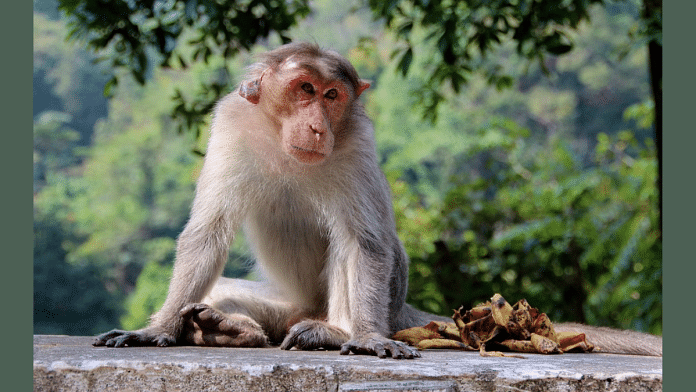History
Monkeys have a longer association with Delhi than humans. During Lord Ram’s period the Aravallis in the landmass we call Delhi was a dense scrub forest teeming with wildlife including monkeys and it had a clean and gushing Yamuna river.
Centuries later on this landmass seven historic cities were established in the following chronological order. Lal Kot or Quila Rai Pithora founded by Tomar King Anangpal II, Siri established by Allauddin Khilji, Tughlaqabad founded by Ghiyasuddin Tughlaq, Jahanpanah established by Muhammad Bin Tughlaq, Firozabad built by Firoz Shah Tughlaq, Dinpanah built by Humanun. In all these cities there was peaceful coexistence between humans and monkeys.
At Present
Delhi, covering 1,483 sq km, is not just India’s capital but also a densely populated urban sprawl with over 33 million residents. Once abundant with forests and clean rivers, today it faces:
- Shrinking green cover due to encroachments and deforestation
- Toxic air pollution, leading to respiratory diseases and reduced life expectancy
- Severely polluted Yamuna, making water unsafe for all life forms
- Overburdened infrastructure, unable to meet the needs of humans, let alone wildlife
Once a city of lively, tolerant people surrounded by biodiversity, Delhi has become an overcrowded metropolis where both humans and monkeys are struggling to survive.
Delhi’s forests are shallow, encroached and unhealthy, its river Yamuna is polluted,its infrastructure is poor, incomplete,insufficient and faulty, its air is toxic and It lacks resources both for humans and its other life forms.
Delhi located in the north- central part of India, with an area of 1483 square kilometres is a union territory, a district, part of the National Capital Region of India and one of the largest urban agglomerations of the country but becoming difficult to live both for humans and other lifeforms.
The Human-Monkey Conflict
For centuries, Delhiites celebrated nature and lived harmoniously with animals, including monkeys. However, rapid urbanization, deforestation, and resource scarcity have created an intense conflict between humans and monkeys.
Today, thousands of monkeys are homeless, forced to scavenge in residential areas. Meanwhile, millions of Delhiites live in substandard conditions, breathing polluted air and consuming unsafe water. The city, once filled with tolerance and cultural richness, is now divided—not just among people but between species.
The conflict is for food, water, and space, and monkeys are fighting back. While humans initiated the struggle by destroying their habitats, monkeys are now asserting their right to exist.
A Path to Peace: How to End the Conflict in One Year
To restore harmony, Delhi must take immediate and strategic action:
1. Create & Enrich Monkey Zones
- Identify areas with large monkey populations and declare them official monkey zones.
- Restore natural habitats by planting monkey-friendly trees, grasses, and climbers.
- Develop water bodies to prevent monkeys from venturing into human settlements for food and water.
2. Train “Monkey Dogs”
- Train street dogs (Indian mongrels) to gently keep monkeys away from human spaces, such as homes, schools, and offices.
- These dogs can be trained in 6–8 months to act as natural deterrents without harming the monkeys.
3. Study Monkey Attractants
- Conduct a comparative study of areas with and without monkey activity to identify what attracts them.
- Educate residents on how to reduce monkey attractants (e.g., open garbage bins, food waste, etc.).
4. Establish Monkey Corridors
- Develop safe, tree-covered monkey corridors to guide them from conflict zones to enriched habitats.
- This ensures they have an easy escape route and do not feel trapped in human settlements.
5. Utilize Monkeys for Positive Human Interaction
- Monkeys can be trained for tasks like coconut picking, reducing their dependence on urban food sources.
- A gentle training method using bamboo poles and coconut dummies can teach them to pick coconuts in 3–6 months.
6. Learn from Lord Ram: Coexist, Don’t Exterminate
- In Hindu tradition, Lord Ram and his people coexisted peacefully with monkeys, respecting their space.
- Worshipping Ram is easy—but following his example requires effort. Delhiites must pledge to respect and restore the ancient harmony between humans and monkeys.
- Lord Ram’s ‘Vanar Sena’ fought the evil enemy so why can’t today’s Vanars fight for their country!
A core group of army personnel, human right activists, animal right activists, primatologists and wildlife experts can sit together, discuss and formulate a list of works which are near the natural behavior of monkeys. The core group will formulate rules and regulations for this program. It will also be vigilant that no one misuses this program, monkeys are not experimented upon or are exploited.
Call to Action
Delhi’s human-monkey conflict is not just about animals—it is a symptom of deeper environmental degradation and poor urban planning. If we take these steps, within a year, Delhi can move towards peace, better health, and a more sustainable future.
We must act now—not just for monkeys, but for Delhi’s people, forests, and future generations.
These pieces are being published as they have been received – they have not been edited/fact-checked by ThePrint.


